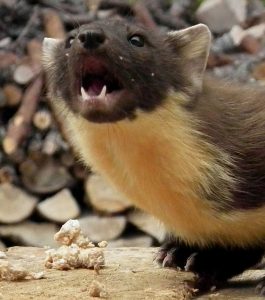 In the last two weeks there has been a dramatic change in the countryside with the trees coming into leaf and the grasses and other vegetation flourishing. The different shades of green on the trees are fascinating and my favourite is the grey green of the aspen leaves but this may be because they are always trembling in the slightest braze. Legend has it that the trembling is because it can never rest as it was cursed as the tree on which Christ was crucified. In fact the leaves are trembling because they have long, flattened leaf stems. The “greening” of the countryside means one major thing to a range of wildlife – cover and shelter. At a time when many mammals and birds have young it means that it is relatively easy to hide from predators and disturbance.
In the last two weeks there has been a dramatic change in the countryside with the trees coming into leaf and the grasses and other vegetation flourishing. The different shades of green on the trees are fascinating and my favourite is the grey green of the aspen leaves but this may be because they are always trembling in the slightest braze. Legend has it that the trembling is because it can never rest as it was cursed as the tree on which Christ was crucified. In fact the leaves are trembling because they have long, flattened leaf stems. The “greening” of the countryside means one major thing to a range of wildlife – cover and shelter. At a time when many mammals and birds have young it means that it is relatively easy to hide from predators and disturbance.
However, to the field naturalists it can be frustrating and the only way forward is to become more of a nature detective. This means that instead of looking for wildlife you look more for the signs of where they have been and, hopefully, what they have been doing. However, wildlife has the advantage that there is so much cover that even if you see fresh signs it can still stay hidden. Interestingly as far as the nocturnal mammals are concerned such as fox, badger and pine marten the nights are so short that they need to be out in some daylight hours just to feed enough. Droppings are a good way to see if any of these three mammals are present and it may surprise people to see just how many gardens are frequented by them. For example, with the pine marten, the droppings are conspicuous being about ten centimetre’s long, twisted and twirled. If you are lucky enough to see a pine marten ( see photograph) you can often tell individuals apart by the size and extent of the creamy yellow throat. Droppings in general are best left where they are as more often than not they will be marking territory which is important.
Signs of feeding can tell you a great deal as I found out in my last visit to the tall pines at the road end of Loch Farr in Strathnairn. I was looking for any scattered pine cones under the trees as they are a giveaway. Some of the cones had been just stripped to the centre of the cone which is the work of a red squirrel. In other cones each scale had been split down the middle. This is the work of the crossbill that has a beak that is crossed to extract the seed. Interestingly a reader had reported small parties of crossbills in that area a few days before. These would be family parties as if the cone/seed harvest is good the crossbills will have already bred this year. Tracks are also important but it needs to be a good print such as in mud to make identification easier. River banks, gateways and roadside verges are good tracking areas. Once you find that mammals are frequent the you can go back and look from a distance. Remember it is important that mammals should not be disturbed.
Considering how important tracks and signs are for the naturalists it is surprising just how few books have been written on the subject. To my mind the best is “Nature Trackers Handbook” by Nick Baker published by Bloomsbury Natural History in 2013 at £14.99. The Nature Trackers Handbook is available direct from the RSPB.
Tags: highland wildlife
